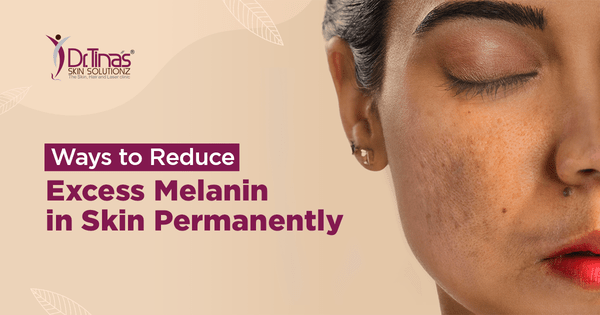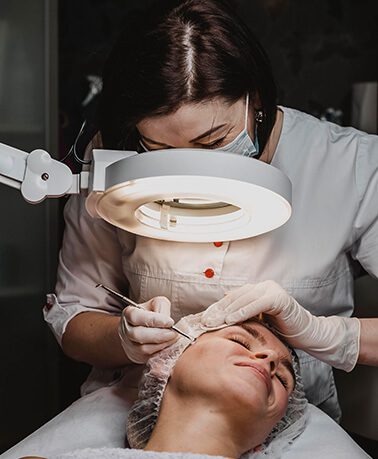Ways To Remove Pigmentation From Face Permanently | Dermatologist Tips (2025)

Brown spots on face? Wondering if it’s the dreaded pigmentation?
Did you know normal Indian skin is naturally pigmented, and it’s common to have darker areas around the eyes, mouth, elbows, knees, and other regions? This is a natural variation in melanin distribution and often not a cause for concern.
Healthy, luminescent skin with good texture and evenly distributed pigment is a shared goal. Skin brightening treatment involves a variety of safe and effective procedures that work holistically to help achieve balanced skin tone. With expert guidance, even-toned skin is an achievable goal.
What Causes Pigmentation on the Face?
Excessive Melanin Production
Melanin is the pigment that gives your skin, hair, and eyes their color. The higher the melanin content in the skin, the darker the skin tone. It plays a protective role by shielding your skin from harmful UV rays and lowering your risk of skin cancer. However, when your skin is overexposed to the sun, it increases melanin production as a defense, leading to darkened areas.
Excessive melanin in specific parts of the face and body can result in the appearance of dark spots or patches. Uneven skin tone can be emotionally distressing, impacting self-esteem. Melanin reduction treatment in Bangalore is recommended for individuals who experience such distress due to pigmentation.
How to Control Excessive Melanin Production-
- Sun Exposure – UV rays trigger melanin production. Over time, this creates sunspots and uneven tone.
- Hormonal Changes – Pregnancy, menopause, and birth control pills may lead to melasma, especially in women.
- Inflammation – Acne, skin injuries, and harsh skin products can cause dark spots during healing.
- Genetics – Some people, especially those with darker skin tones (Fitzpatrick IV–VI), are more prone to pigmentation.
Can you Reduce Melanin in Skin Permanently?
While home remedies are often popular, they tend to offer limited and inconsistent results. Advanced dermatological treatments offer faster, safer, and more reliable options. Below are some of the most effective & dermatologist approved treatments to remove pigmentation permanently from face:
1. Topical Medications
Topical treatments are ideal for mild to moderate pigmentation. They work by inhibiting melanin production and include agents such as:
- # Kojic acid
- # Glycolic acid
- # Azelaic acid
- # Vitamin C (ascorbic acid)
- # Retinoids (tretinoin)
- # Niacinamide
- # Hydroquinone (used with medical supervision due to potential side effects)
- # Cysteamine hydrochloride (a newer and promising alternative)
These ingredients work at the cellular level to lighten dark spots and improve skin tone over time.
2. Chemical Peels
Chemical peels involve the controlled application of acids like glycolic, mandelic, lactic, or salicylic acids that exfoliate the top layers of the skin. This encourages the regeneration of new, more evenly pigmented skin. Suitable for treating:
- Sun damage
- Melasma
- Acne scars
For Indian skin, it’s important to use superficial to medium-depth peels under the care of a qualified dermatologist to avoid complications like post-inflammatory hyperpigmentation.
3. Laser Therapy
Laser treatments such as Q-switched Nd:YAG or Pico lasers are effective in reducing pigmentation. They work by targeting melanin with precise energy bursts that break up pigment without damaging surrounding tissue. Benefits include:
- Safe for darker skin types
- Treats stubborn pigmentation
- Stimulates collagen for improved skin texture
Multiple sessions (typically spaced 4-6 weeks apart) are often required for optimal results.
4. Intense Pulsed Light (IPL) Therapy
IPL is a light-based treatment that targets melanin without being as aggressive as lasers. It is effective for:
- Freckles
- Age spots
- Mild sun damage
However, IPL is best suited for lighter skin tones, and must be cautiously used on Indian skin with appropriate filters and expertise.
5. Mesotherapy with Tranexamic Acid
Mesotherapy involves micro-injections of skin-brightening ingredients into the middle layer of skin. When combined with tranexamic acid, it effectively reduces melasma and other pigmentary disorders. Mesotherapy can be further enhanced by PRP (Platelet Rich Plasma) therapy.
6. Oral Treatments
In addition to topical and procedural options, dermatologists may recommend oral supplements containing:
- Procyanidin
- Glutathione
- Vitamins A, C, and E
- Polypodium leucotomos extract
These help reduce oxidative stress and support skin lightening from within.
Home Remedies for Mild Pigmentation
Home remedies work slowly and are best for supporting your treatment. Always patch test first.
- Aloe Vera – Apply fresh gel overnight. Reduces melanin with a compound called aloesin.
- Lemon Juice + Honey – Vitamin C in lemon brightens skin. Mix 1 tsp lemon with 1 tsp honey; apply for 10 mins, rinse off. Avoid sun exposure after application.
- Milk + Turmeric – Milk exfoliates gently; turmeric brightens. Apply 3 times a week.
- Green Tea Compress – Cool steeped tea bags and place on dark spots for 10 minutes.
Prevention and Maintenance
While these treatments can significantly reduce pigmentation, maintaining results is crucial. Prevention strategies include:
- Daily use of broad-spectrum sunscreen (SPF 30 or higher)
- Avoiding peak sun hours (10 am to 4 pm)
- Wearing hats and protective clothing
- Gentle skincare routine with non-irritating products
Set Realistic Expectations
It’s important to understand that while pigmentation can be significantly reduced, a complete change in natural complexion is not realistic. Results vary based on skin type, severity, and consistency in treatment. It’s always the quality of skin which reflects glow is preferred compared to damaged skin due to excessive harsh creams or procedures
Consult a Dermatologist
Before undergoing any skin whitening or pigmentation treatment in Bangalore, consult a qualified dermatologist. They can assess your skin type, identify the root cause of pigmentation, and recommend the safest and most effective treatment plan tailored to your needs.
Recommended Reading – Pigmentation Around Mouth: Causes, Treatment and Prevention
Frequently Asked Questions (FAQs)
1. Can pigmentation be removed permanently?
Yes! With the right professional treatment and proper aftercare, pigmentation can be permanently reduced not removed .maintenance is needed to prevent recurrence.
2. How long does it take to see results?
- Mild cases: 4–8 weeks
- Deep pigmentation: 3–6 months with consistent care
3. Are home remedies enough to remove pigmentation?
They may help fade mild pigmentation over time, but they aren’t a permanent solution. Dermatological treatments offer faster, long-lasting results.
4. Which is the best treatment for pigmentation?
Laser treatments and chemical peels are the most effective, especially when combined with prescription creams and sun protection.

Dr.Tina Ramachander is one of the best dermatologist in Bangalore and Medical Director at Dr.Tina’s Skin Solutionz, a skin care clinic in Bangalore. She completed her master’s in dermatology from the well acclaimed JJM Medical college in Karnataka and is now a practicising dermatosurgeon and Medical Cosmetologist in Bangalore.

